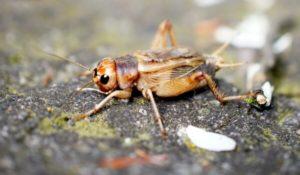Cricket Repellent: 9 Methods to Effectively Get Rid of Insects
Among the huge variety of insects, there are both beneficial species and dangerous pests. With bees or the Colorado potato beetle, no questions arise in this topic, but there are many species that are constantly being debated. One of these are crickets.
Content
What harm can crickets cause
If a lone "singer" appeared on the territory of the site, then most likely there will be no harm from him. But, since these insects are able to reproduce very quickly, then soon a small group of several dozen individuals will appear in the place of one cricket. As a result, a flock of insects can turn into a whole horde that can bring a lot of problems.
Why are crickets dangerous in the garden
Crickets are almost omnivores and a significant part of their diet is plant foods. Insects do not mind feasting on both young tender sprouts and stems or leaves of adult crops. Cricket infestations can damage plants such as:
- carrot;
- potatoes;
- beet;
- bow;
- wheat;
- tomatoes;
- corn;
- beans.
Why are crickets dangerous in the house
Having made their way into the house, the cricket will most likely simply disturb the peace of the household with its loud “singing” at night. But, if a whole group of insects settles in a dwelling, then together they can harm such things as:
- clothes;
- furniture;
- wiring;
- walls;
- decor elements;
- paper products.
Reasons for the appearance of crickets
The appearance of crickets in the garden or vegetable garden is a common thing. These insects are able to move long distances by jumping or flying, and it will not be difficult for them to change their place of habitual habitat.
Location on
The appearance of a large colony of crickets on the site may indicate that the insects have found a suitable place for wintering.
It can be:
- old stumps;
- logs;
- heaps of construction debris.
In room
Warm residential buildings are also great for this purpose. Additional factors that attract crickets to a person's home are:
- high humidity;
- the constant presence of food waste in the trash;
- bread crumbs and other food leftovers in the public domain;
- lack of mosquito nets on the windows;
- bright illumination of the house at night.
How to get rid of crickets
If one cricket appeared on the site or in the house, which does not cause any problems, then there is no particular need to fight it. But if in the evening you can hear the “singing” of a whole group of insects, this is a sure signal that it is time to take this issue seriously.
Mechanical methods
Mechanical methods are most often simple to perform and quite effective, but they are only suitable if there are not very many insects. The most effective are:
You can make them yourself or buy ready-made ones in the store. Traps should be placed along baseboards, under sinks, and near trash bins.
With the help of a powerful device, you can catch not only adults, but also egg-laying scattered around the house, which are difficult to see with the naked eye.
In order to attract crickets to the trap, fodder molasses should be used. To catch insects, it is enough to leave a deep dish half-filled with water overnight, and place a small amount of molasses on the bottom.
Chemicals
If the problem with crickets on the site was not resolved in a timely manner, then most likely it is impossible to do without the use of insecticides. For the effective destruction of adults and oviposition, Dichlorvos-based products are perfect, such as:
- Neo;
- monitor lizard;
- Super.
Among experienced gardeners, the use of solutions based on Karbofos and Decis preparations is also popular.
Biological methods
Such control methods are considered safe for plants and the environment, and therefore are especially appreciated by fans of natural farming.
Biological methods can be divided into treatment with biological products and attraction of natural enemies of cricket to the site.
As for the natural enemies of this insect, the best allies in the fight against them will be tits or starlings. To attract feathered helpers to the site, it is enough to hang several feeders and regularly fill them with various treats.
Traditional recipes
The use of folk recipes for fighting crickets also brings good results. Among the time-tested means, the most popular are the following:
- spraying the beds with a strong decoction of wormwood (1 kg of fresh raw materials per bucket of water, boil for 30 minutes);
- scattering between the rows of plants of a dry mixture of tobacco dust and finely ground red pepper;
- laying out naphthalene balls or tablets in the habitats of crickets.
Prevention of the appearance of crickets
Even if the war with insects ended not in their favor, it is worth taking the necessary measures to prevent the re-population of crickets on the site. The main measures to protect the house and garden from the invasion of uninvited guests are:
- use of mosquito nets on windows;
- timely cleaning of food waste;
- maintaining a normal level of humidity in the room;
- closing all small holes and cracks in walls, windows and floors;
- installation of special gratings on the ventilation openings;
- maintaining order in the local area and timely removal of garbage;
- arrangement of compost heaps as far as possible from residential premises.
Conclusion
Lonely crickets that fill summer evenings with their singing are not a threat to plants in the garden or things in the house, so do not try to destroy them. It is enough just to follow the recommendations for prevention and prevent the mass reproduction of insects, or their penetration into the house.
Previous


